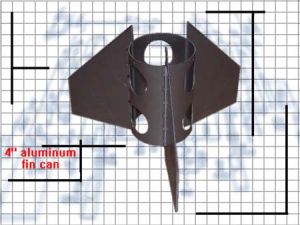Hawk Mountain Enterprises Aluminum Fin Can for 4" Airframe
Hawk Mountain Enterprises - Aluminum Fin Can for 4" Airframe
Contributed by Jack Caynon
| Construction Rating: | starstarstarstarstar_border |
| Flight Rating: | starstarstarstarstar |
| Overall Rating: | starstarstarstarstar_border |
| Manufacturer: | Hawk Mountain Enterprises  |

Brief:
Pre-manufactured aluminum fin can you bolt together
Construction:
For those of us who want a rugged fin can to handle high thrust applications with 4 inch fiberglass tubing, Hawk
Mountain has manufactured a nifty 3 fin aluminum fin can for its 4 inch airframes. The unit is machined from 6061-T6
aluminum with beveled 0.125” thick fins. The fin can weighs 25 ounces and is black anodized to resist corrosion
and can be painted with regular paint. The root is 8.25 inches and the span is 5 inches. Although the picture shows
some cutouts in the aluminum flanges, my unit had no cutouts whatsoever.
The instructions were fairly easy to follow, but there were no illustrations that guided you regarding assembly. The assembly order is logical if you give it some thought. I suggest that you first construct the fin can then work on your motor mount tube and centering rings after you have the fin can constructed so you can measure where your centering rings (only applicable for 3 inch motor applications) need to go in relation to the fin can's holes to attach it to the airframe.
For tools, you'll need a Phillips head screw driver (or allen wrench), a power drill, and drill bit set.
To attach the fin can to the airframe, you'll need to provide your own screws (6), either self-tapping or set screws.
Basically, the fin can is made up of three flanges and three fins. The way it works is that you sandwich a fin root between the left edge of one flange and the right edge of another then screw the two flanges together with the screws passing through holes drilled in the fin root. You loosely connect the next flange, fin, flange combination until all three of the fins and the three flanges form a fin can. Then before you tighten all of the screws, you slide the fin can onto your airframe. Now, find two small holes, one at the top center and the other at the bottom center of each flange. Once your motor mount tube with centering rings is installed inside the airframe place the holes over the area where your centering rings around the motor mount tube touch the inside of your airframe and drill holes through the fin can's holes into the airframe and centering rings. Now you can tighten all of the screws on the flanges, then screw self-tapping screws into the centering rings through each of the fin can holes to attach the fin can to the airframe.
For 4 inch minimum diameter applications, use set screws to attach the fin can to the fiberglass tubing. Make certain that your set screws do not interfere with the motor casing on the inside of the airframe.
PROs: No need to worry about alignment issues, fit, or sturdiness. Ease of construction.
CONs: Instructions could be a little clearer. It weighs a pound and a half. You need to provide your own hardware to attach the fin can to the airframe.
Finishing:
The anodized black aluminum looks pretty cool to me, so I won't bother having it painted.
Construction Rating: 4 out of 5
Flight:
Use can use this fin can with any 98mm motor, commercial or experimental, as well as any high thrust 75mm M motor.
Flight Rating: 5 out of 5
Summary:
I can't think of a easier way of installing a bulletproof fin can on a rocket that won't shred when subjected to high
thrust motors. The PROs are that there are no alignment issues to speak of and the sturdy construction of the unit.
Although it isn't a lightweight by any stretch of the imagination, for minimum diameter 98 mm motor applications, the
25 ounces isn't really much of a problem and shouldn't keep you from thinking about using it. I would recommend it for
4 inch airframes using high thrust, 75mm M motors and 4 inch minimum diameter applications.
Overall Rating: 4 out of 5
 |
 |
A.K.S. (December 3, 2007)
J.C. (December 6, 2007)
J.B. (December 8, 2007)
K.D. (December 23, 2007)
J.C. (May 30, 2008)
J.C. (July 23, 2008)
J.C. (November 14, 2008)
J.C. (May 14, 2009)
Sponsored Ads
 |
 |












L.B. (November 22, 2007)